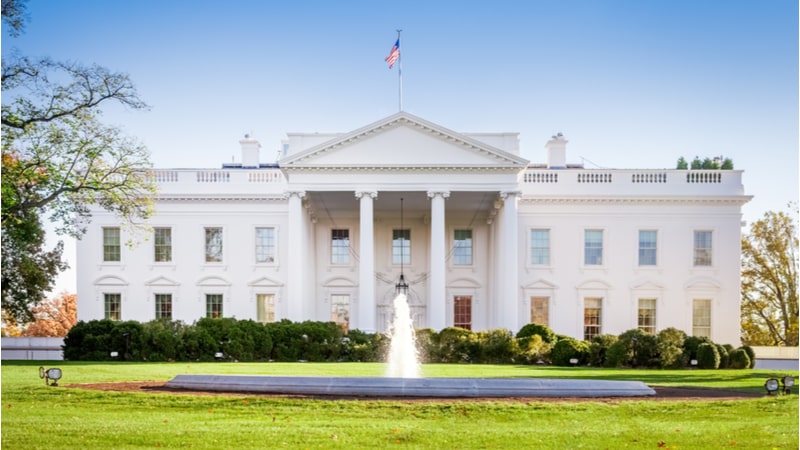
Securing artificial intelligence data centers, building-up American semiconductor manufacturing, and training the workforce for an AI-centric world are among the Trump administration’s dominant priorities laid out this week in its new AI Action Plan.
Released on July 23, the action plan serves as the Trump administration’s blueprint for accelerating the development, deployment and use of AI across the nation. We’re breaking down some of those efforts so that you can know what to expect in the coming months and years.
Semiconductors
Semiconductors, a key component of AI systems hardware, have historically been produced primarily in Taiwan, South Korea, and China. In recent years, due to national and economic security concerns, along with aims to reduce dependence, the United States has adopted policies to bolster domestic semiconductor manufacturing.
Former President Joe Biden signed the CHIPS and Science Act into law in August 2022, making up to $52 billion of funding available to incentivize semiconductor makers to establish new domestic manufacturing operations.
Despite criticisms of the CHIPS Act by President Donald Trump, his administration plans to continue the program while removing “all extraneous policy requirements for CHIPS-funded semiconductor manufacturing projects.”
“A revitalized U.S. chip industry will generate thousands of high-paying jobs, reinforce our technological leadership, and protect our supply chains from disruption by foreign rivals,” the White House said in the AI action plan. “The Trump Administration will lead that revitalization without making bad deals for the American taxpayer or saddling companies with sweeping ideological agendas.”
The Department of Commerce (DoC), which oversees the CHIPS program, is being tapped under the AI action plan to also collaborate with other Federal agencies to “streamline regulations” that slow those manufacturing efforts, and lead reviews of semiconductor grant and research programs to integrate advanced AI tools into production processes.
Critical Infrastructure & Cybersecurity
The Trump administration recommended several policy actions in the action plan that aim to protect critical infrastructure through the use of AI, including by deploying systems that are “secure-by-design, robust, and resilient” and that can “detect performance shifts, and alert to potential malicious activities like data poisoning or adversarial example attacks.”
Efforts to deploy those systems include establishing an AI Information Sharing and Analysis Center to be led by the Department of Homeland Security (DHS) in collaboration with the DoC’s Center for AI Standards and Innovation and the Office of the National Cyber Director. The center will “promote the sharing of AI-security threat information and intelligence across U.S. critical infrastructure sectors.”
DHS will also be responsible for creating guidance for industry on addressing and responding to AI-specific vulnerabilities and threats and information sharing of known vulnerabilities from within Federal agencies to the private sector. Information sharing efforts will “take advantage of existing cyber vulnerability sharing mechanisms,” according to the White House.
“Maintaining a robust defensive posture will be especially important for owners of critical infrastructure, many of whom operate with limited financial resources,” said the White House in its action plan.
AI systems themselves are also attracting policy actions to bolster their cyber planning, with the White House noting that the “proliferation of AI technologies means that prudent planning is required to ensure that, if systems fail, the impacts to critical services or infrastructure are minimized and response is imminent.”
“To prepare for such an eventuality, the U.S. government should promote the development and incorporation of AI Incident Response actions into existing incident response doctrine and best-practices for both the public and private sectors,” said the White House.
The Trump administration said that Federal agencies should integrate AI into cybersecurity efforts by developing standards and rapid-response tools, led by work to be undertaken by the National Institute of Standards and Technology.
The Cybersecurity Infrastructure and Security Agency is being tasked with revising playbooks to address AI risks and ensure coordination between security and AI officials while defense and intelligence agencies are also encouraged to share AI vulnerability information.
Workforce Development & Training
In a flurry of policy actions intended to train the workforce necessary to “build, operate, and maintain” AI-related infrastructure and energy sources, the Trump administration said it would “identify the priority roles that underpin AI infrastructure, develop modern skills frameworks, support industry driven training, and expand early pipelines through general education, CTE, and Registered Apprenticeships to fuel American AI leadership.”
Under those policies, the Departments of Labor and Commerce will launch a national initiative to identify critical occupations needed for AI infrastructure and develop voluntary skill frameworks to guide curriculum and workforce investments.
Federal agencies will also partner with local governments and employers to co-develop training programs that ensure participants are job-ready for high-demand AI roles, with funding prioritized for those that effectively fill talent gaps.
Efforts will also expand early exposure programs for middle and high school students and increase access to Registered Apprenticeships in AI-related fields by streamlining processes and aligning training with industry needs.
Meanwhile, the Department of Education will help modernize career and technical education programs to reflect AI workforce priorities, and the Department of Energy will grow hands-on AI research opportunities across education levels.
